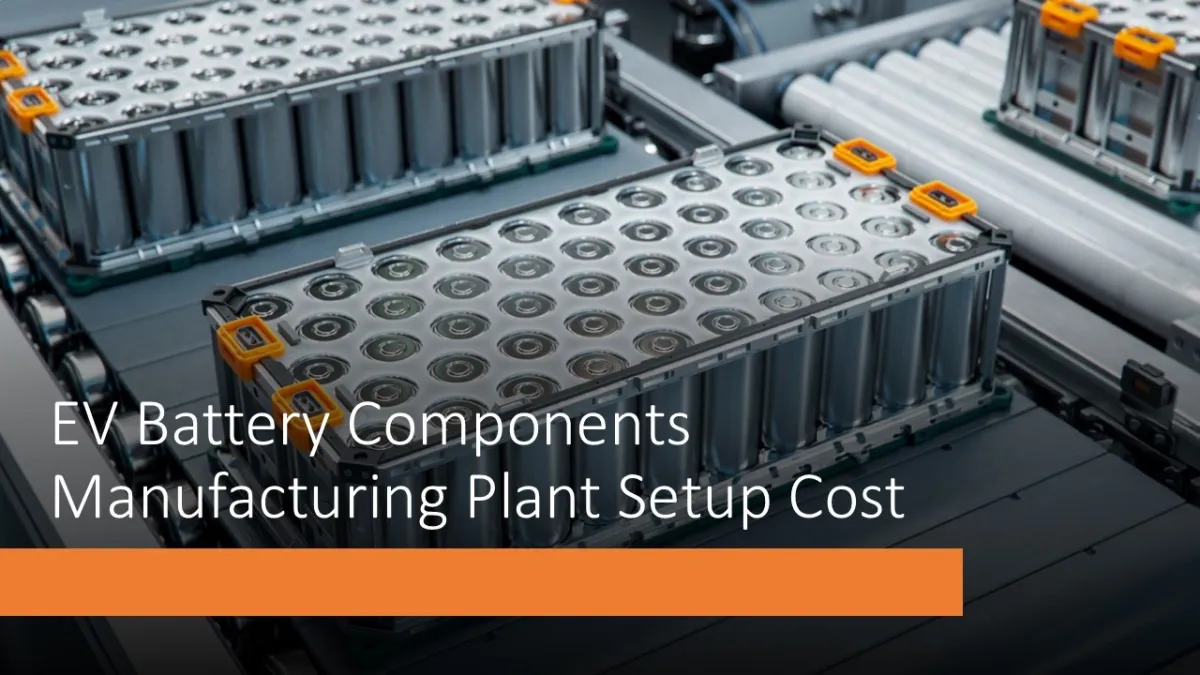EV Battery Components Manufacturing Plant Setup Report 2025: Machinery Requirement, And Cost Analysis
Setting up an EV battery components manufacturing plant involves sourcing high-purity raw materials, installing cell assembly, module fabrication, BMS integration, and quality testing machinery. Skilled labor, safety protocols, energy supply, and strict environmental compliance are essential for efficient, high-quality production.
IMARC Group's report, titled “EV Battery Components Manufacturing Plant Project Report 2025: Industry Trends, Plant Setup, Machinery, Raw Materials, Investment Opportunities, Cost and Revenue,” provides a complete roadmap for setting up a EV battery components manufacturing plant. It covers a comprehensive market overview to micro-level information such as unit operations involved, raw material requirements, utility requirements, infrastructure requirements, machinery and technology requirements, manpower requirements, packaging requirements, transportation requirements, etc.
Request for a Sample Report : https://www.imarcgroup.com/ev-battery-components-manufacturing-plant-project-report/requestsample
EV Battery Components Industry Outlook 2025
The EV battery components industry is set for strong growth in 2025, driven by rising electric vehicle adoption and advancements in battery technology like lithium iron phosphate, NCA, and solid-state batteries. Demand for batteries is surging, with markets expanding globally, especially in Asia-Pacific. Sustainability and recycling initiatives are gaining focus, reducing reliance on raw materials. Geopolitical shifts and trade policies are reshaping supply chains, prompting investments in new manufacturing facilities worldwide. Companies that innovate, embrace eco-friendly practices, and adapt to changing regulations are well-positioned to capitalize on the rapidly growing EV battery market.
Key Insights for EV Battery Components Manufacturing Plant Setup
Detailed Process Flow
-
Product Overview
Unit Operations Involved
Mass Balance and Raw Material Requirements
Quality Assurance Criteria
Technical Tests
Project Details, Requirements and Costs Involved:
-
Land, Location and Site Development
Plant Layout
Machinery Requirements and Costs
Raw Material Requirements and Costs
Packaging Requirements and Costs
Transportation Requirements and Costs
Utility Requirements and Costs
Human Resource Requirements and Costs
Capital Expenditure (CapEx) and Operational Expenditure (OpEx) Analysis:
Project Economics:
-
Capital Investments
Operating Costs
Expenditure Projections
Revenue Projections
Taxation and Depreciation
Profit Projections
Financial Analysis
Profitability Analysis:
-
Total Income
Total Expenditure
Gross Profit
Gross Margin
Net Profit
Net Margin
Key Cost Components of Setting Up an EV Battery Components Plant
-
Land and Building: Acquisition or lease of land and construction of factory, warehouses, and office space.
Machinery and Equipment: Battery cell assembly lines, electrode production, coating machines, drying ovens, and quality testing equipment.
Raw Materials: Lithium, cobalt, nickel, graphite, electrolytes, separators, and other chemicals.
Utilities and Infrastructure: Power supply, water, HVAC systems, compressed air, and waste treatment facilities.
Labor Costs: Skilled and unskilled workforce for production, R&D, and management.
Technology and Licensing: Patents, proprietary technology, software, and process licensing fees.
Working Capital: Initial inventory, operational expenses, logistics, and contingency funds.
Economic Trends Influencing EV Battery Components Plant Setup Cost 2025
-
Raw Material Price Volatility: Prices of lithium, nickel, cobalt, and copper are fluctuating due to rising demand, affecting production costs.
Inflation and Rising Input Costs: Construction materials, machinery, and labor costs are increasing, impacting total setup budgets.
High Interest Rates: Elevated borrowing costs make financing new plants more expensive for capital-intensive projects.
Government Incentives and Support: Subsidies, tax breaks, and EV-friendly policies help reduce effective setup costs.
Global Supply Chain Realignment: Localizing supply chains raises initial investment but reduces long-term dependency on imports.
Request for Customized Report: https://www.imarcgroup.com/request?type=report&id=31162&flag=E
Challenges and Considerations for Investors
-
High Capital Investment: Setting up battery component plants requires substantial upfront costs for land, machinery, and technology.
Raw Material Dependency: Reliance on critical materials like lithium, cobalt, and nickel exposes investors to price volatility and supply risks.
Technological Complexity: Rapid advancements in battery chemistry and manufacturing processes require continuous R&D and skilled workforce.
Regulatory and Policy Risks: Changes in environmental, trade, or EV incentive policies can impact profitability.
Competition: Growing number of global players increases market competition, affecting margins.
Supply Chain Disruptions: Geopolitical tensions or transport bottlenecks can delay production and increase costs.
Market Demand Uncertainty: EV adoption rates and battery technology shifts influence long-term demand projections.
EV Battery Components Industry Expansion in 2025
The EV battery components industry is rapidly expanding in 2025, driven by rising electric vehicle adoption, technological advancements, and government incentives. Global EV sales reached 17 million units in 2024, with the EV fleet expected to quadruple by 2030, fueling demand for batteries and related materials.
Conclusion
The EV battery components industry is set for strong growth, driven by rising electric vehicle adoption, technological advancements, and sustainability initiatives. Although plant setup requires high investment, skilled labor, and raw material management, strategic planning, innovation, and regulatory compliance can ensure efficient production and long-term profitability for investors.
About Us: IMARC Group is a global management consulting firm that helps the world's most ambitious changemakers to create a lasting impact. The company excel in understanding its client's business priorities and delivering tailored solutions that drive meaningful outcomes. We provide a comprehensive suite of market entry and expansion services. Our offerings include thorough market assessment, feasibility studies, company incorporation assistance, factory setup support, regulatory approvals and licensing navigation, branding, marketing and sales strategies, competitive landscape, and benchmarking analyses, pricing and cost research, and procurement research.
Contact Us:
IMARC Group
134 N 4th St. Brooklyn, NY 11249, USA
Email:
Tel No:(D) +91 120 433 0800
United States: +1-201971-6302
Legal Disclaimer:
MENAFN provides the
information “as is” without warranty of any kind. We do not accept
any responsibility or liability for the accuracy, content, images,
videos, licenses, completeness, legality, or reliability of the information
contained in this article. If you have any complaints or copyright
issues related to this article, kindly contact the provider above.
Most popular stories
Market Research

- 1Inch Becomes First Swap Provider Relaunched On OKX Wallet
- Ecosync & Carboncore Launch Full Stages Refi Infrastructure Linking Carbon Credits With Web3
- Leverage Shares Launches First 3X Single-Stock Etps On HOOD, HIMS, UNH And Others
- GCL Subsidiary, 2Game Digital, Partners With Kucoin Pay To Accept Secure Crypto Payments In Real Time
- Kintsu Launches Shype On Hyperliquid
- PLPC-DBTM: Non-Cellular Oncology Immunotherapy With STIPNAM Traceability, Entering A Global Acquisition Window.






















Comments
No comment